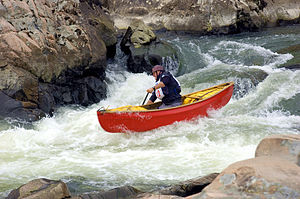Key:oneway:boat
| Description |
|---|
| Whether bidirectional boat travel is possible and allowed. |
| Group: restrictions |
| Used on these elements |
| Useful combination |
|
| Status: in use |
| Tools for this tag |
|
The tag oneway:boat=* is used on waterway=* features to indicate whether or not watercraft (given by access tag boat=*) can travel in both directions. The oneway=* tag alone is sometimes used for this but other times is used for the direction of flow, so oneway:boat=* avoids ambiguity.
How to map
Oneway travel is based on two factors, if it's allowed and if it's possible. Generally two-way travel is allowed on waterways; look for posted signage and pay special attention around canals and water locks. More often, oneway travel is restricted only by river rapids or strong currents.
- oneway:boat=no – boats can travel in both directions
- oneway:boat=yes – boats can travel only in the direction of the way (usually meaning downstream)
Different types of watercraft have different abilities to power upstream and may be subject to separate regulations. Use the following tags when a type of boat has its own restrictions.
- oneway:canoe=* – oneway access for canoe=*
- oneway:motorboat=* – oneway access for motorboat=*
- oneway:sailboat=* – oneway access for sailboat=*
If two segments of a waterway have different conditions, such as above and below a dam, be sure to split the way and add specific oneway tags for each section.
Implied values
To avoid ambiguity, mappers should add oneway:boat=* to every navigable stretch of waterway. When no value is present, watercraft routers should exercise caution but can make the following assumptions.
Tags that generally imply oneway:boat=yes: rapids=yes, waterway=river, waterway=stream.
Tags that generally imply oneway:boat=no: tidal=yes, waterway=canal, waterway=link, waterway=fairway, waterway=flowline.

